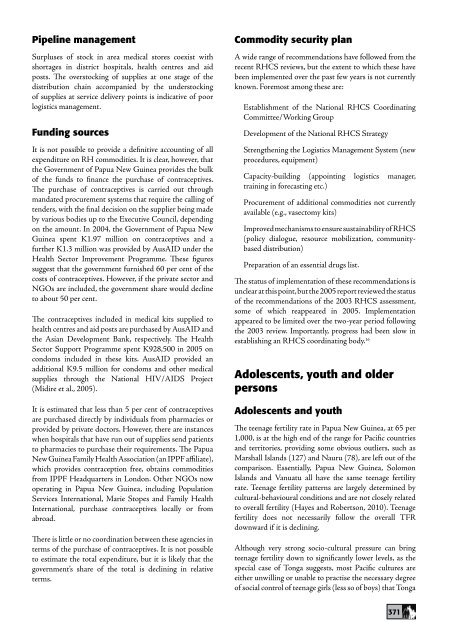Family Planning in Asia and the Pacific - International Council on ...
Family Planning in Asia and the Pacific - International Council on ...
Family Planning in Asia and the Pacific - International Council on ...
You also want an ePaper? Increase the reach of your titles
YUMPU automatically turns print PDFs into web optimized ePapers that Google loves.
Pipel<str<strong>on</strong>g>in</str<strong>on</strong>g>e managementSurpluses of stock <str<strong>on</strong>g>in</str<strong>on</strong>g> area medical stores coexist withshortages <str<strong>on</strong>g>in</str<strong>on</strong>g> district hospitals, health centres <str<strong>on</strong>g>and</str<strong>on</strong>g> aidposts. The overstock<str<strong>on</strong>g>in</str<strong>on</strong>g>g of supplies at <strong>on</strong>e stage of <str<strong>on</strong>g>the</str<strong>on</strong>g>distributi<strong>on</strong> cha<str<strong>on</strong>g>in</str<strong>on</strong>g> accompanied by <str<strong>on</strong>g>the</str<strong>on</strong>g> understock<str<strong>on</strong>g>in</str<strong>on</strong>g>gof supplies at service delivery po<str<strong>on</strong>g>in</str<strong>on</strong>g>ts is <str<strong>on</strong>g>in</str<strong>on</strong>g>dicative of poorlogistics management.Fund<str<strong>on</strong>g>in</str<strong>on</strong>g>g sourcesIt is not possible to provide a def<str<strong>on</strong>g>in</str<strong>on</strong>g>itive account<str<strong>on</strong>g>in</str<strong>on</strong>g>g of allexpenditure <strong>on</strong> RH commodities. It is clear, however, that<str<strong>on</strong>g>the</str<strong>on</strong>g> Government of Papua New Gu<str<strong>on</strong>g>in</str<strong>on</strong>g>ea provides <str<strong>on</strong>g>the</str<strong>on</strong>g> bulkof <str<strong>on</strong>g>the</str<strong>on</strong>g> funds to f<str<strong>on</strong>g>in</str<strong>on</strong>g>ance <str<strong>on</strong>g>the</str<strong>on</strong>g> purchase of c<strong>on</strong>traceptives.The purchase of c<strong>on</strong>traceptives is carried out throughm<str<strong>on</strong>g>and</str<strong>on</strong>g>ated procurement systems that require <str<strong>on</strong>g>the</str<strong>on</strong>g> call<str<strong>on</strong>g>in</str<strong>on</strong>g>g oftenders, with <str<strong>on</strong>g>the</str<strong>on</strong>g> f<str<strong>on</strong>g>in</str<strong>on</strong>g>al decisi<strong>on</strong> <strong>on</strong> <str<strong>on</strong>g>the</str<strong>on</strong>g> supplier be<str<strong>on</strong>g>in</str<strong>on</strong>g>g madeby various bodies up to <str<strong>on</strong>g>the</str<strong>on</strong>g> Executive <str<strong>on</strong>g>Council</str<strong>on</strong>g>, depend<str<strong>on</strong>g>in</str<strong>on</strong>g>g<strong>on</strong> <str<strong>on</strong>g>the</str<strong>on</strong>g> amount. In 2004, <str<strong>on</strong>g>the</str<strong>on</strong>g> Government of Papua NewGu<str<strong>on</strong>g>in</str<strong>on</strong>g>ea spent K1.97 milli<strong>on</strong> <strong>on</strong> c<strong>on</strong>traceptives <str<strong>on</strong>g>and</str<strong>on</strong>g> afur<str<strong>on</strong>g>the</str<strong>on</strong>g>r K1.3 milli<strong>on</strong> was provided by AusAID under <str<strong>on</strong>g>the</str<strong>on</strong>g>Health Sector Improvement Programme. These figuressuggest that <str<strong>on</strong>g>the</str<strong>on</strong>g> government furnished 60 per cent of <str<strong>on</strong>g>the</str<strong>on</strong>g>costs of c<strong>on</strong>traceptives. However, if <str<strong>on</strong>g>the</str<strong>on</strong>g> private sector <str<strong>on</strong>g>and</str<strong>on</strong>g>NGOs are <str<strong>on</strong>g>in</str<strong>on</strong>g>cluded, <str<strong>on</strong>g>the</str<strong>on</strong>g> government share would decl<str<strong>on</strong>g>in</str<strong>on</strong>g>eto about 50 per cent.The c<strong>on</strong>traceptives <str<strong>on</strong>g>in</str<strong>on</strong>g>cluded <str<strong>on</strong>g>in</str<strong>on</strong>g> medical kits supplied tohealth centres <str<strong>on</strong>g>and</str<strong>on</strong>g> aid posts are purchased by AusAID <str<strong>on</strong>g>and</str<strong>on</strong>g><str<strong>on</strong>g>the</str<strong>on</strong>g> <str<strong>on</strong>g>Asia</str<strong>on</strong>g>n Development Bank, respectively. The HealthSector Support Programme spent K928,500 <str<strong>on</strong>g>in</str<strong>on</strong>g> 2005 <strong>on</strong>c<strong>on</strong>doms <str<strong>on</strong>g>in</str<strong>on</strong>g>cluded <str<strong>on</strong>g>in</str<strong>on</strong>g> <str<strong>on</strong>g>the</str<strong>on</strong>g>se kits. AusAID provided anadditi<strong>on</strong>al K9.5 milli<strong>on</strong> for c<strong>on</strong>doms <str<strong>on</strong>g>and</str<strong>on</strong>g> o<str<strong>on</strong>g>the</str<strong>on</strong>g>r medicalsupplies through <str<strong>on</strong>g>the</str<strong>on</strong>g> Nati<strong>on</strong>al HIV/AIDS Project(Midire et al., 2005).It is estimated that less than 5 per cent of c<strong>on</strong>traceptivesare purchased directly by <str<strong>on</strong>g>in</str<strong>on</strong>g>dividuals from pharmacies orprovided by private doctors. However, <str<strong>on</strong>g>the</str<strong>on</strong>g>re are <str<strong>on</strong>g>in</str<strong>on</strong>g>stanceswhen hospitals that have run out of supplies send patientsto pharmacies to purchase <str<strong>on</strong>g>the</str<strong>on</strong>g>ir requirements. The PapuaNew Gu<str<strong>on</strong>g>in</str<strong>on</strong>g>ea <str<strong>on</strong>g>Family</str<strong>on</strong>g> Health Associati<strong>on</strong> (an IPPF affiliate),which provides c<strong>on</strong>tracepti<strong>on</strong> free, obta<str<strong>on</strong>g>in</str<strong>on</strong>g>s commoditiesfrom IPPF Headquarters <str<strong>on</strong>g>in</str<strong>on</strong>g> L<strong>on</strong>d<strong>on</strong>. O<str<strong>on</strong>g>the</str<strong>on</strong>g>r NGOs nowoperat<str<strong>on</strong>g>in</str<strong>on</strong>g>g <str<strong>on</strong>g>in</str<strong>on</strong>g> Papua New Gu<str<strong>on</strong>g>in</str<strong>on</strong>g>ea, <str<strong>on</strong>g>in</str<strong>on</strong>g>clud<str<strong>on</strong>g>in</str<strong>on</strong>g>g Populati<strong>on</strong>Services <str<strong>on</strong>g>Internati<strong>on</strong>al</str<strong>on</strong>g>, Marie Stopes <str<strong>on</strong>g>and</str<strong>on</strong>g> <str<strong>on</strong>g>Family</str<strong>on</strong>g> Health<str<strong>on</strong>g>Internati<strong>on</strong>al</str<strong>on</strong>g>, purchase c<strong>on</strong>traceptives locally or fromabroad.There is little or no coord<str<strong>on</strong>g>in</str<strong>on</strong>g>ati<strong>on</strong> between <str<strong>on</strong>g>the</str<strong>on</strong>g>se agencies <str<strong>on</strong>g>in</str<strong>on</strong>g>terms of <str<strong>on</strong>g>the</str<strong>on</strong>g> purchase of c<strong>on</strong>traceptives. It is not possibleto estimate <str<strong>on</strong>g>the</str<strong>on</strong>g> total expenditure, but it is likely that <str<strong>on</strong>g>the</str<strong>on</strong>g>government’s share of <str<strong>on</strong>g>the</str<strong>on</strong>g> total is decl<str<strong>on</strong>g>in</str<strong>on</strong>g><str<strong>on</strong>g>in</str<strong>on</strong>g>g <str<strong>on</strong>g>in</str<strong>on</strong>g> relativeterms.Commodity security planA wide range of recommendati<strong>on</strong>s have followed from <str<strong>on</strong>g>the</str<strong>on</strong>g>recent RHCS reviews, but <str<strong>on</strong>g>the</str<strong>on</strong>g> extent to which <str<strong>on</strong>g>the</str<strong>on</strong>g>se havebeen implemented over <str<strong>on</strong>g>the</str<strong>on</strong>g> past few years is not currentlyknown. Foremost am<strong>on</strong>g <str<strong>on</strong>g>the</str<strong>on</strong>g>se are:Establishment of <str<strong>on</strong>g>the</str<strong>on</strong>g> Nati<strong>on</strong>al RHCS Coord<str<strong>on</strong>g>in</str<strong>on</strong>g>at<str<strong>on</strong>g>in</str<strong>on</strong>g>gCommittee/Work<str<strong>on</strong>g>in</str<strong>on</strong>g>g GroupDevelopment of <str<strong>on</strong>g>the</str<strong>on</strong>g> Nati<strong>on</strong>al RHCS StrategyStreng<str<strong>on</strong>g>the</str<strong>on</strong>g>n<str<strong>on</strong>g>in</str<strong>on</strong>g>g <str<strong>on</strong>g>the</str<strong>on</strong>g> Logistics Management System (newprocedures, equipment)Capacity-build<str<strong>on</strong>g>in</str<strong>on</strong>g>g (appo<str<strong>on</strong>g>in</str<strong>on</strong>g>t<str<strong>on</strong>g>in</str<strong>on</strong>g>g logistics manager,tra<str<strong>on</strong>g>in</str<strong>on</strong>g><str<strong>on</strong>g>in</str<strong>on</strong>g>g <str<strong>on</strong>g>in</str<strong>on</strong>g> forecast<str<strong>on</strong>g>in</str<strong>on</strong>g>g etc.)Procurement of additi<strong>on</strong>al commodities not currentlyavailable (e.g., vasectomy kits)Improved mechanisms to ensure susta<str<strong>on</strong>g>in</str<strong>on</strong>g>ability of RHCS(policy dialogue, resource mobilizati<strong>on</strong>, communitybaseddistributi<strong>on</strong>)Preparati<strong>on</strong> of an essential drugs list.The status of implementati<strong>on</strong> of <str<strong>on</strong>g>the</str<strong>on</strong>g>se recommendati<strong>on</strong>s isunclear at this po<str<strong>on</strong>g>in</str<strong>on</strong>g>t, but <str<strong>on</strong>g>the</str<strong>on</strong>g> 2005 report reviewed <str<strong>on</strong>g>the</str<strong>on</strong>g> statusof <str<strong>on</strong>g>the</str<strong>on</strong>g> recommendati<strong>on</strong>s of <str<strong>on</strong>g>the</str<strong>on</strong>g> 2003 RHCS assessment,some of which reappeared <str<strong>on</strong>g>in</str<strong>on</strong>g> 2005. Implementati<strong>on</strong>appeared to be limited over <str<strong>on</strong>g>the</str<strong>on</strong>g> two-year period follow<str<strong>on</strong>g>in</str<strong>on</strong>g>g<str<strong>on</strong>g>the</str<strong>on</strong>g> 2003 review. Importantly, progress had been slow <str<strong>on</strong>g>in</str<strong>on</strong>g>establish<str<strong>on</strong>g>in</str<strong>on</strong>g>g an RHCS coord<str<strong>on</strong>g>in</str<strong>on</strong>g>at<str<strong>on</strong>g>in</str<strong>on</strong>g>g body. 16Adolescents, youth <str<strong>on</strong>g>and</str<strong>on</strong>g> olderpers<strong>on</strong>sAdolescents <str<strong>on</strong>g>and</str<strong>on</strong>g> youthThe teenage fertility rate <str<strong>on</strong>g>in</str<strong>on</strong>g> Papua New Gu<str<strong>on</strong>g>in</str<strong>on</strong>g>ea, at 65 per1,000, is at <str<strong>on</strong>g>the</str<strong>on</strong>g> high end of <str<strong>on</strong>g>the</str<strong>on</strong>g> range for <str<strong>on</strong>g>Pacific</str<strong>on</strong>g> countries<str<strong>on</strong>g>and</str<strong>on</strong>g> territories, provid<str<strong>on</strong>g>in</str<strong>on</strong>g>g some obvious outliers, such asMarshall Isl<str<strong>on</strong>g>and</str<strong>on</strong>g>s (127) <str<strong>on</strong>g>and</str<strong>on</strong>g> Nauru (78), are left out of <str<strong>on</strong>g>the</str<strong>on</strong>g>comparis<strong>on</strong>. Essentially, Papua New Gu<str<strong>on</strong>g>in</str<strong>on</strong>g>ea, Solom<strong>on</strong>Isl<str<strong>on</strong>g>and</str<strong>on</strong>g>s <str<strong>on</strong>g>and</str<strong>on</strong>g> Vanuatu all have <str<strong>on</strong>g>the</str<strong>on</strong>g> same teenage fertilityrate. Teenage fertility patterns are largely determ<str<strong>on</strong>g>in</str<strong>on</strong>g>ed bycultural-behavioural c<strong>on</strong>diti<strong>on</strong>s <str<strong>on</strong>g>and</str<strong>on</strong>g> are not closely relatedto overall fertility (Hayes <str<strong>on</strong>g>and</str<strong>on</strong>g> Roberts<strong>on</strong>, 2010). Teenagefertility does not necessarily follow <str<strong>on</strong>g>the</str<strong>on</strong>g> overall TFRdownward if it is decl<str<strong>on</strong>g>in</str<strong>on</strong>g><str<strong>on</strong>g>in</str<strong>on</strong>g>g.Although very str<strong>on</strong>g socio-cultural pressure can br<str<strong>on</strong>g>in</str<strong>on</strong>g>gteenage fertility down to significantly lower levels, as <str<strong>on</strong>g>the</str<strong>on</strong>g>special case of T<strong>on</strong>ga suggests, most <str<strong>on</strong>g>Pacific</str<strong>on</strong>g> cultures areei<str<strong>on</strong>g>the</str<strong>on</strong>g>r unwill<str<strong>on</strong>g>in</str<strong>on</strong>g>g or unable to practise <str<strong>on</strong>g>the</str<strong>on</strong>g> necessary degreeof social c<strong>on</strong>trol of teenage girls (less so of boys) that T<strong>on</strong>ga371














